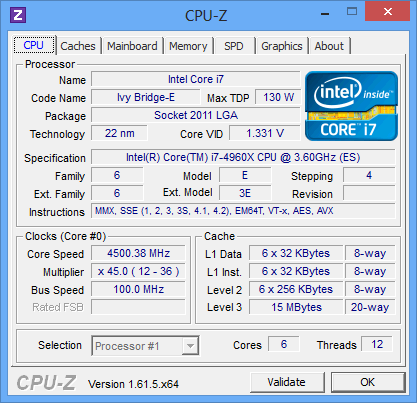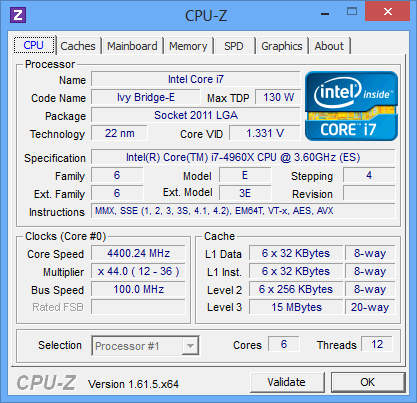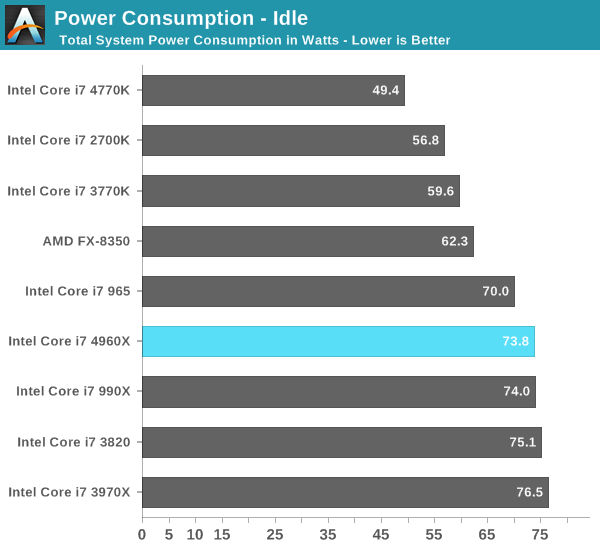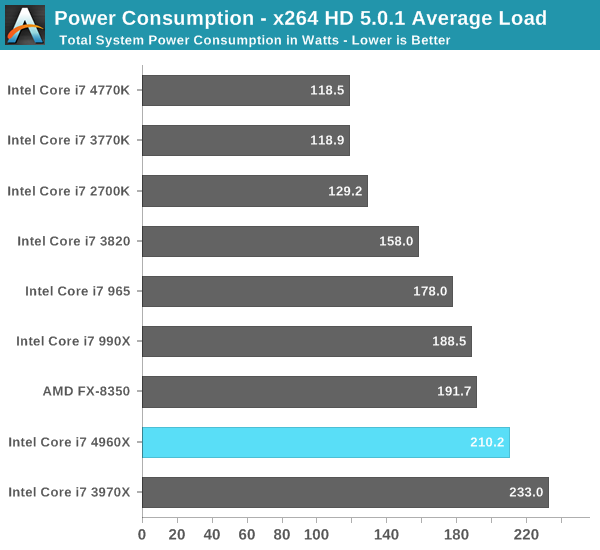Intel Core i7 4960X (Ivy Bridge E) Review
by Anand Lal Shimpi on September 3, 2013 4:10 AM EST- Posted in
- CPUs
- Intel
- Ivy Bridge
- Ivy Bridge-E
Overclocking
As I mentioned earlier, all of the IVB-E launch SKUs ship fully unlocked. Intel offers multipliers up to 63x for you to choose from when overclocking. Like SNB-E before it, IVB-E supports specific BCLK straps (125MHz and 166MHz, in addition to 100MHz) for those overclockers looking to get the absolute most out of their chip. At these overclocked BCLK frequencies, PCIe and other buses are properly divided down so they aren't overclocked (although if you increase the BCLK frequency beyond these strap defaults you will once again be overclocking other buses that derive their frequencies from BCLK). In practice, the cleanest/simplest way to overclock any K-series SKU is by increasing the multiplier.

In our review of the Core i7-3960X I managed a maximum stable overclock of 4.6GHz. I've been told to expect a similar average for Ivy Bridge E. Using Intel's RTS2011LC self contained/closed loop liquid cooling solution I could get into Windows 8 as high as 4.6GHz at 1.42V, however my testbed wasn't stable through all of my tests at that frequency/voltage combination. Moving to higher voltages didn't help, so I had to back down on frequency. I ultimately ended up perfectly stable at 4.3GHz, with 4.4 - 4.5GHz possible with better cooling. The added power needed to hit these frequencies was substantial. I measured a 58W increase in average load power consumption at 4.3GHz/1.4V.

From what I've seen, my sample is a bit on the disappointing side in terms of overclockability. Either way, it doesn't look like you're going to be seeing overclocks significantly higher than what was possible with SNB-E.
Power Consumption
With the 4960X delivering around 5% better performance than the 3970X, the only remaining question is how much more power efficient the move to 22nm made things. Using the same ASUS X79 Deluxe board for both parts, I was able to answer that question.
At idle there's hardly any difference between SNB-E and IVB-E. Under load it looks like IVB-E is good for around a 20W reduction in total system power. It's not an insignificant savings, but definitely not enough to warrant an upgrade if you're on SNB-E already. Anyone looking to migrate to LGA-2011 for the first time will want to go with IVB-E as it is the more thermally efficient solution.












120 Comments
View All Comments
knirfie - Tuesday, September 3, 2013 - link
Why not use a gaming benchmark that does benefit from the extra cores, such as Civ5?ShieTar - Tuesday, September 3, 2013 - link
Or Starcraft 2?JarredWalton - Tuesday, September 3, 2013 - link
Hahahaha.... best 1.5 core benchmark around!althaz - Tuesday, September 3, 2013 - link
It sure does murder one core though.BrightCandle - Tuesday, September 3, 2013 - link
or Arma 3.There are games out there that can utilise more cores and yet you didn't test with any of them.
bds71 - Tuesday, September 3, 2013 - link
as someone who regularly does encoding, 4k gaming, and (when not in use otherwise) folding@home - all things which can fully leverage mult-core processors and powerfull GPUs - i look forward to these reviews of new enthusiast class processors. and, it saddens me that since SB-E there have been only marginal improvements in this sector. i never thought we (as a technology power-house, and as a society) would settle for this. for me, it all began when they started putting GPUs on-die with CPUs for desktop PCs (sure, for laptops i can certainly understand) - i mean who DOESN'T use a discreet GPU in a desktop system???? and for those who do, why don't you just get a laptop???GPUs on-die took the focus away from the CPU. and, while there are minimal gains to be had, the showing here today is abysmal. 2 yrs of waiting and we get a 5% increase (for what i do, i want power and could really care less about power draw - as i would say most enthusiasts do). i get it - to build more powerful hardware, it HAS to become more efficient, but it's an evolutionary development process. haswell could very easily be an enthusiast class product: get rid of the rediculous GPU (for the desktop), double the core count, and raise the TDP to 125/130 (haswell-E?) - and they could do it a LOT earlier than 1-2 years from now. come on Intel - stop screwing the guys who you built your reputation on (after all, it's always the fastest/most powerfull hardware that's shown in reviews to boost the reputation of any company).
/rant off/ sorry, this is just very dissapointing.
f0d - Tuesday, September 3, 2013 - link
i agree very disappointingtoo much integration and not enough performance is the problem with modern intel cpus
i dont want integrated graphics and vrm's and whatever else they plan on integrating - i want huge core counts in a single die for the enthusiast platform.!
jabber - Tuesday, September 3, 2013 - link
I think what folks forget is -Just how many of these chips does Intel actually sell a year?
I bet it's tiny. I bet the i3/i5 chips outsell them 50 to 1. Thats why stuff isn't happening at the top so much. The demand has dwindled. Ten years ago a lot of people could eat all the cpu power they could get their hands on. Now? Not so much. Plenty people now still happy with their 2008/9 spec quads. Basically these top end Intel i7 chips are the Mercedes S class. A way for Intel to put new stuff and techniques in, that may or may not filter down in the future generations.
Intel knows the figures and it knows that the action is at the other end of the spectrum. Not for folks that largely want to rip video and run benchmarks all day.
f0d - Tuesday, September 3, 2013 - link
i agree they dont sell as many as the lower end cpu's but why not just sell us an unlocked xeon than can also OC?its not like they would lose money from letting us OC the xeon because the people that would normally buy a xeon for servers etc would never think about overclocking them
then its a win/win situation for intel as they are still getting their xeon money and they will have a decent enthusiast cpu also
and yes i would happily pay 1k (the price i can find current SBE 8 core cpu's) for an OCable 8 core
jabber - Tuesday, September 3, 2013 - link
Indeed and in being happy to pay $1000 for a CPU that puts you in a very very small group.Times are tough. Sell low and sell many.